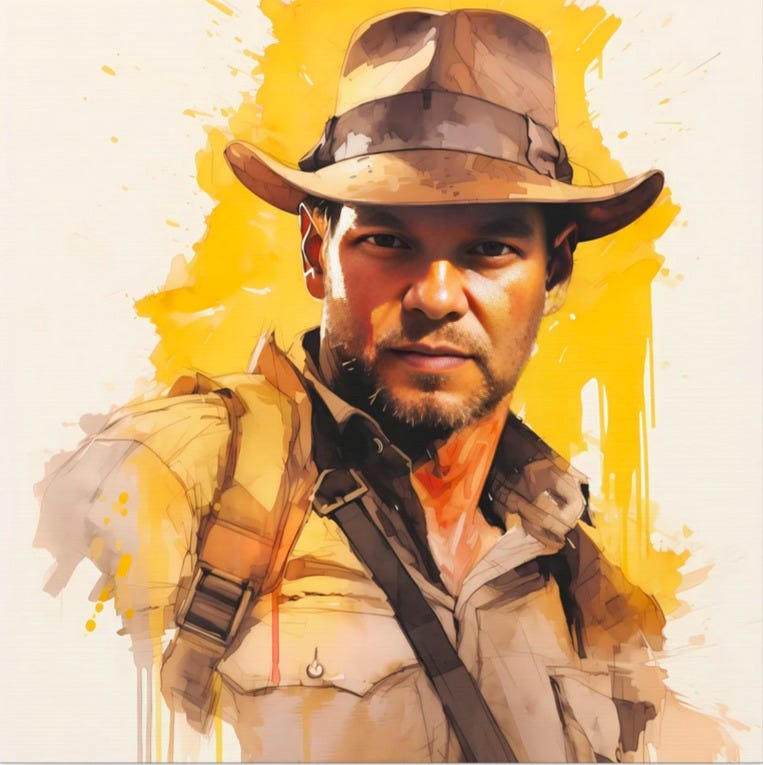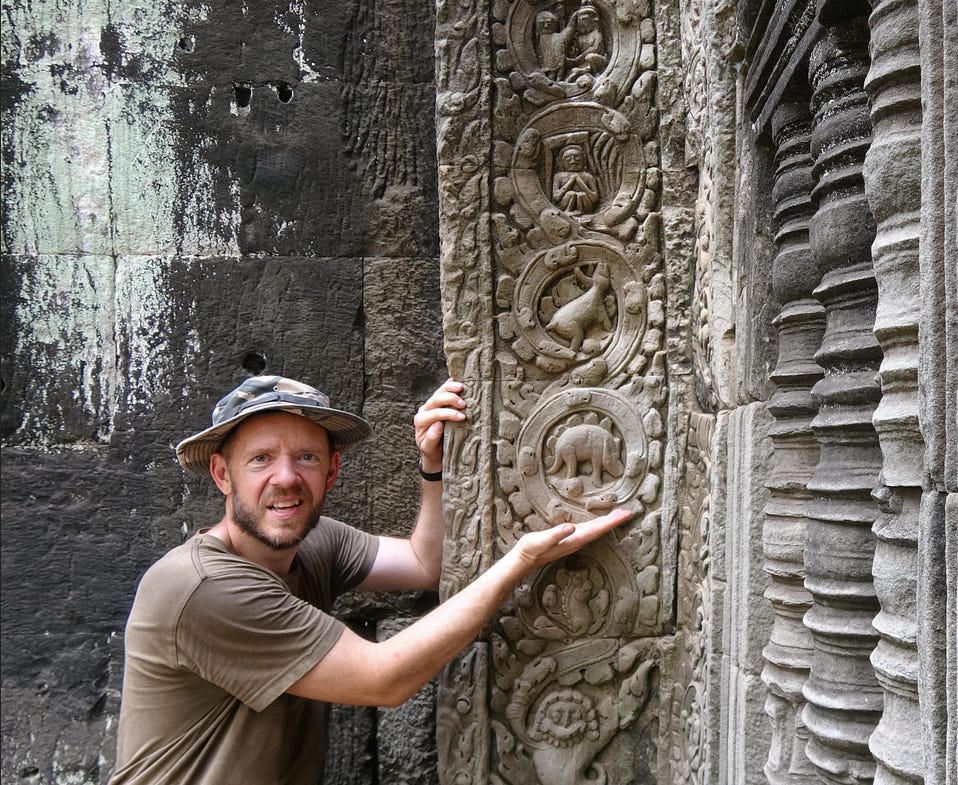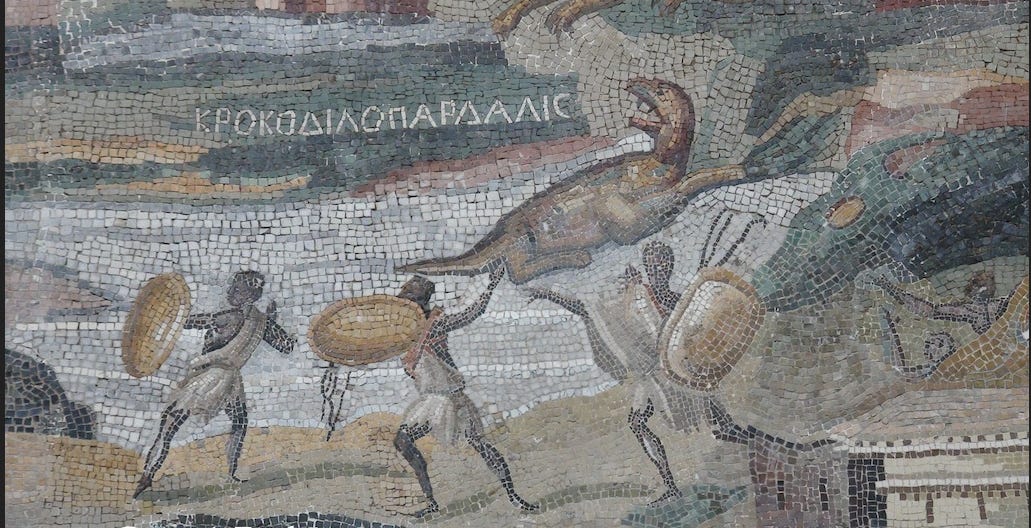Dragon Legends- Part 2
Petroglyphs at Natural Bridges, Utah
In 2012, I visited the dinosaur petroglyph, located in the Natural Bridges National Monument in Utah. This amazing pictograph represents a remarkable creature created by the ancient Anasazi people, who inhabited the region from approximately 150 B.C. to 1200 A.D. This petroglyph, which some interpret as resembling a Sauropod dinosaur due to its elongated neck and tail, has sparked considerable interest. Even outspoken critics of creationism acknowledge that the image bears a striking resemblance to a dinosaur. They also recognize that the brownish film hardened over the pictograph, along with its pitting and weathering, indicates significant age. One evolutionist noted, “There is a petroglyph in Natural Bridges National Monument that bears a startling resemblance to a dinosaur, specifically a Brontosaurus, with a long tail and neck, small head and all.”1 The carving, located near Lake Powell, Utah, clearly portrays a native warrior (positioned to the left above the dinosaur-like figure) alongside what appears to be an Apatosaur-like creature. Additionally, another Native American rock pictograph discovered in Utah’s White Canyon region also seems to depict a sauropod dinosaur.
While various interpretations of this carving exist, its striking resemblance to a dinosaur is a point of significant observation. See my video “Dinosaur Pictograph: Kachina Bridge”.
Evidence of Dinosaurs at Angkor Wat, Cambodia
Numerous sites suggest historical evidence of humans and dinosaurs coexisting. These include the petroglyphs at Natural Bridges National Monument in Utah, dragon legends throughout Europe, and the widespread dragon motifs in Chinese culture. However, one of the most striking yet lesser-known pieces of evidence comes from Southeast Asia: a bas-relief carving at the ruins of Angkor, near Siem Reap, Cambodia, which appears to depict a Stegosaur dinosaur.
Angkor is a vast complex of ruins from the Khmer Empire, which flourished in Southeast Asia from the late ninth century to the late twelfth century. This collection of ancient structures includes temples, palaces, libraries, monasteries, and other buildings, many of which were constructed by successive Khmer rulers. Today, these ruins are preserved within the Angkor Archaeological Park in the Kingdom of Cambodia. Over the years, extensive restoration efforts have been undertaken to maintain and protect these structures.2
One particularly notable site within Angkor is Angkor Thom, a collection of ruins intentionally left in a semi-natural state. Constructed during the reign of King Jayavarman VII (A.D. 1181–ca. 1210), Angkor Thom includes the great temple-monastery of Ta Prohm. Unlike many other Angkorian temples that have been extensively restored, Ta Prohm has been left largely untouched, with its ruins dramatically intertwined with jungle vines and the massive roots of strangler fig trees. The Angkor Conservancy chose to maintain this condition to provide visitors with a sense of adventure and exploration.3
A Mysterious Carving at Ta Prohm
Angkor’s temples feature intricate bas-reliefs depicting a mixture of Hindu deities, Buddhist influences, and real-world animals such as elephants, fish, snakes, and monkeys. Some of these carvings also resemble dragon-like creatures similar to those found in Chinese mythology—elongated, serpent-like figures with legs and claws.
However, among the roundels on pilasters at the west entrance of Ta Prohm, a particularly unusual carving stands out. While most of the roundels depict recognizable animals—such as pigs, roosters, water buffalo, and monkeys—one figure appears to resemble a dinosaur. Notably, there are no mythological creatures among these roundels, suggesting that the carvings represent animals that the ancient Khmer people were familiar with in their everyday lives.4
This raises a fascinating question: if the Khmer artisans carved what they observed in the twelfth century, could dinosaurs have still been present in the region of Cambodia just 800 years ago?
Dino Dave pictured below
Other Accounts of Dinosaurs
Additionally, historical accounts exist describing what some believe to be living dinosaurs. In 1271 A.D. Marco Polo came back from China and reported that the Emperor of China was raising dragons to pull his chariots in parades. Now why on earth would Marco Polo say something like that just 700 years ago? Well, I think he probably said that because the Emperor of China was raising dragons to pull his chariots in parades. The 13th-century explorer Marco Polo recorded sightings of "huge serpents" in China:
“At the fore part, near the head, they have two short legs, each with three claws, as well as eyes larger than a loaf and very glaring. The jaws are wide enough to swallow a man, the teeth are large and sharp, and their whole appearance is so formidable that neither man, nor any kind of animal can approach them without terror.” 5
Located in Palestrina, just south of Rome, this remarkable mosaic illustrates scenes along the Nile, spanning from Egypt to Ethiopia. Scholars now attribute the work to Demetrius the Topographer, an Alexandrian artist who traveled to Rome. The upper portion of this intricate masterpiece is widely believed to depict African wildlife being hunted by black warriors, likely representing Ethiopians. Among the animals being pursued is a mysterious reptilian creature resembling a dinosaur.
Above this figure, Greek letters spell out KROKODILOPARDALIS, which translates to "Crocodile-Leopard," suggesting an agile, reptilian predator. The mosaic, an expansive work of art, features a wide array of recognizable animals, including Egyptian crocodiles and hippopotamuses, reinforcing its detailed and naturalistic representation of the ancient world.
During the age of sailing ships from about the time of Columbus up until about 100 years ago when they put diesel engines and steam engines on the boats (they make a lot of noise now), but when the boats were more quiet just with wind power, there are literally thousands of legends of people sighting sea monsters. Why would so many ships’ captains come back and say they saw a sea monster? Over and over, you read the old log books and they report sighting a sea monster. And the descriptions certainly sound like they are seeing a dinosaur.
A missionary, Hans Edgar, to Greenland reported sighting a sea monster. The Bishop of Norway reported a sea monster in 1755. Captain Peter McKay on board HMS Nautilus reported sighting a sea monster. He said, “My whole crew watched it for 20 minutes. It just went right under the boat.” He said, “If it had been a man of mine acquaintance I could have recognized him easily with the naked eye.” And they were looking at it through telescopes. Got very good views of this thing.
Many stories exist in the last few hundred years of the days of sailing ships about people sighting these sea monsters. A famous man, who later died on the Titanic, was one of the officers, in 1907 he reported he saw a sea monster swimming south of Ireland. A German submarine commander reported that when he sank a British ship during World War I, a gigantic sea animal came flying up out of the water from the explosion. It had four big flippers. Perhaps some type of plesiosaur.
The Vikings, just 1,000 years ago, had dragon heads on their ships. There are all sorts of Scandinavian legends about somebody slaying a dragon. The famous Scandinavian warrior named Sigurd slew the dragon Fafnir and rescued the treasure that the dragon was hiding, or somebody hid it in a cave and the dragon was living in the cave.
In May 2012, researcher Vance Nelson highlighted a remarkable panel of pictographs discovered on a rock ledge at the edge of the Amazon rainforest basin near Yamon, in the northern province of Utcubamba, Peru. According to secular archaeologists, this artwork dates back thousands of years. Intriguingly, one of the pictographs depicts nine warriors in pursuit of what strongly resembles a dinosaur. In the 1940s, American explorer Percy Fawcett reported sightings of a large, dinosaur-like creature from this very region of the Amazon.
Amazon Dinosaur Pictograph
Final Thoughts
While mainstream science argues that dragons are purely mythical, the existence of dragon-like creatures remains an open question when examined through the lens of biblical history and ancient accounts. Many dragon characteristics—large size, armored bodies, and even fire-related abilities—can be found in real animals. The widespread presence of dragon legends across cultures may indicate that these stories were inspired by actual encounters with now-extinct reptiles.
For creationists, the logic aligns seamlessly: dragons were likely dinosaurs or other large reptilian creatures that coexisted with humans. Although some aspects of dragon lore may have been embellished over time, the core truth behind these legends may be much closer to reality than many are willing to admit.
If you look at it from a biblical perspective, it makes sense. Dinosaurs did live along man. There are legends all through history of people sighting these dinosaurs. They certainly did not live millions and millions of years ago like the textbook says.
PS. If you loved this article, you’ll love seeing “Dinosaur Pictograph: Kachina Bridge”, the film “Forbidden History of Dinosaurs” and our “Out of Place Artifacts” Digital Library. Be sure to head over to our Ancient Pathways Patreon site.
Footnotes:
Barnes, Fred A., and Pendleton, Michaelene. Prehistoric Indians: Their Cultures, Ruins, Artifacts and Rock Art. 1979, p. 201.
Freeman, M. (1999). Ancient Angkor. Bangkok: River Books.
Rooney, D. F. (1994). Angkor: An Introduction to the Temples. Hong Kong: Odyssey Publications
Gibbons, G. (1998). The Mystery of the Cambodian Stegosaurus. Creation Research Society Quarterly, 35(2), 128-133.













